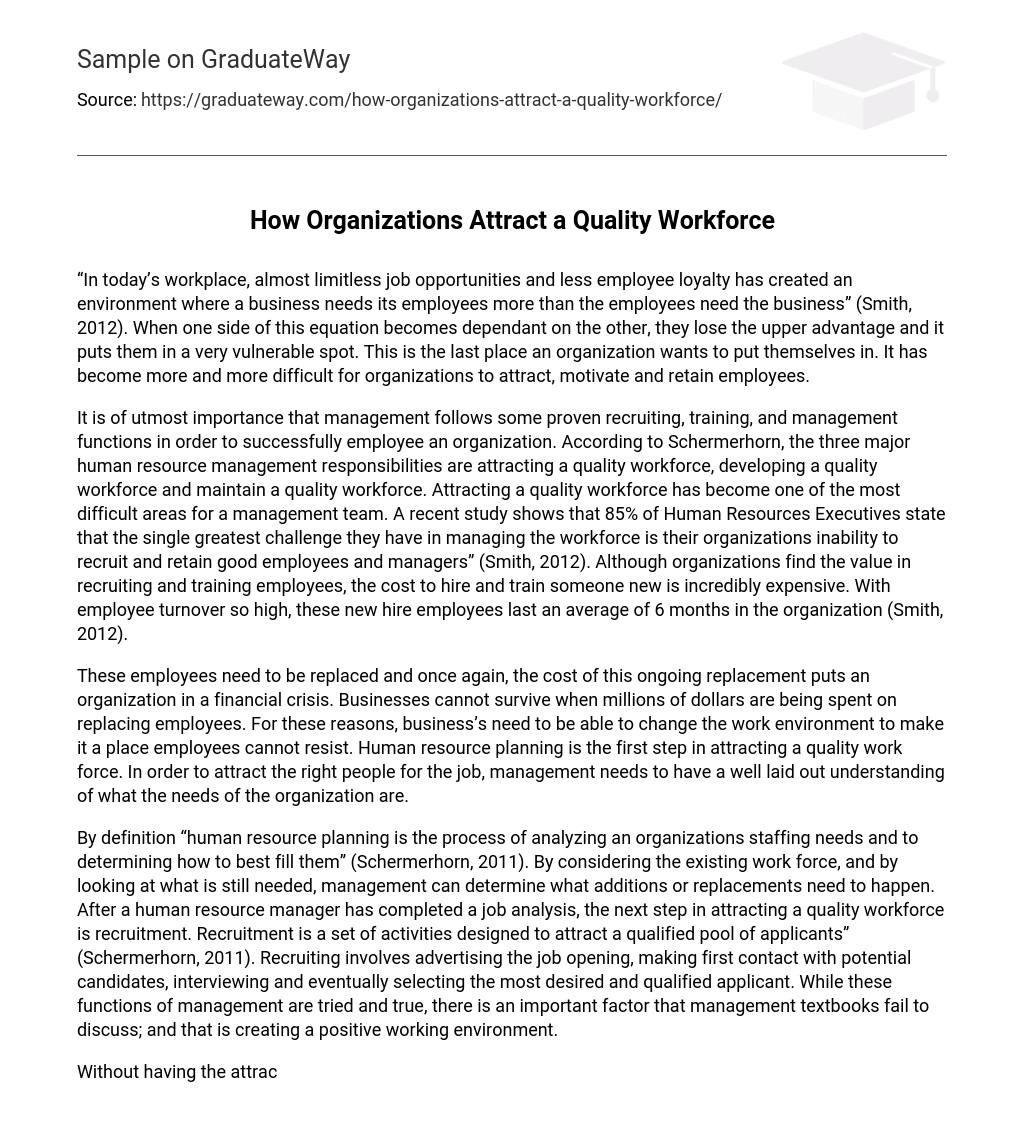“In today’s workplace, almost limitless job opportunities and less employee loyalty has created an environment where a business needs its employees more than the employees need the business” (Smith, 2012). When one side of this equation becomes dependant on the other, they lose the upper advantage and it puts them in a very vulnerable spot. This is the last place an organization wants to put themselves in. It has become more and more difficult for organizations to attract, motivate and retain employees.
It is of utmost importance that management follows some proven recruiting, training, and management functions in order to successfully employee an organization. According to Schermerhorn, the three major human resource management responsibilities are attracting a quality workforce, developing a quality workforce and maintain a quality workforce. Attracting a quality workforce has become one of the most difficult areas for a management team. A recent study shows that 85% of Human Resources Executives state that the single greatest challenge they have in managing the workforce is their organizations inability to recruit and retain good employees and managers” (Smith, 2012). Although organizations find the value in recruiting and training employees, the cost to hire and train someone new is incredibly expensive. With employee turnover so high, these new hire employees last an average of 6 months in the organization (Smith, 2012).
These employees need to be replaced and once again, the cost of this ongoing replacement puts an organization in a financial crisis. Businesses cannot survive when millions of dollars are being spent on replacing employees. For these reasons, business’s need to be able to change the work environment to make it a place employees cannot resist. Human resource planning is the first step in attracting a quality work force. In order to attract the right people for the job, management needs to have a well laid out understanding of what the needs of the organization are.
By definition “human resource planning is the process of analyzing an organizations staffing needs and to determining how to best fill them” (Schermerhorn, 2011). By considering the existing work force, and by looking at what is still needed, management can determine what additions or replacements need to happen. After a human resource manager has completed a job analysis, the next step in attracting a quality workforce is recruitment. Recruitment is a set of activities designed to attract a qualified pool of applicants” (Schermerhorn, 2011). Recruiting involves advertising the job opening, making first contact with potential candidates, interviewing and eventually selecting the most desired and qualified applicant. While these functions of management are tried and true, there is an important factor that management textbooks fail to discuss; and that is creating a positive working environment.
Without having the attractiveness of a positive working environment, the pool of applicants will not consist of the most qualified, because there people will be applying with an organization that creates this positive environment. It is said that “hiring good people is tough…keeping them can be even harder” (Harvard Business Review). An organization can put a lot of effort and resources into hiring a great workforce, but if there are no systems in place to motivate, encourage, and nurture employees, retaining them can be a challenge.
Employees look for flexibility, competitive salaries, work-life balance, and health benefits. Flexibility programs are becoming essential for many employers to attract and retain the talented workers they need (Schermerhorn, 2011). It is also important for employees to feel that their voices are heard. Employees need to be kept engaged. Engagement has been defined as a persistent state of work fulfillment. This fulfillment translates into enthusiasm and passion, higher than average levels of concentration, focus and energy (RETENSA, 2012).
People are more committed and engaged when they can contribute their ideas and suggestions (Smith, 2012). Pay is also very important in keeping employees motivated. They way pay increases are subsequently handled can have a big impact on employees job attitudes, motivation and performance and influence their tendencies to “look around” for better jobs elsewhere (Schermerhorn, 2011). The role that human resource management has in attracting, motivating and retaining a quality workforce is a very important responsibility for the uccess of an organization. Taking the appropriate amount of time to research, and analyze the positions needed within the organization, creating a positive environment, and motivating and engaging employees are critical roles in accomplishing such a task. Following proven management techniques, listening to employees and creating a creative unique environment will lead to a quality workforce, that wants to be there and work hard, and that will continue to be committed to the organization they work for.
References:
RETENSA. (2012). Keeping Employees Engaged . Retrieved November 17, 2012, from ATTCNetwork: www. attcnetwork. org/explore/priorityareas/wfd/grow/engagment. asp Schermerhorn, D. J. (2011). Management 11 Edition. Hoboken New Jersey: John Wiley and Sons Inc. . Smith, G. (n. d. ). 5 Tips to Attract, Keep and Motivate Employees. Retrieved 11 16, 2012, from Businessknowhow. com: www. businessknowhow. com/manage/attractworkforce. htm





